CP5046 Research Report: Database Support for Workflow Management
VerifiedAdded on 2023/06/04
|18
|5134
|428
Report
AI Summary
This report delves into the concept of database support for workflow management systems, particularly in the context of developing a mobile application using SQLite. It provides a comprehensive discussion of SQL, elaborating on different SQL types and their applications. The report highlights the selection of SQLite for mobile application development due to its simplicity and lack of requirement for additional servers, as data is accessed from a backend server. It also includes a case study of the XYZ Dataflow Management System application, showcasing the implementation of a SQLite database for workflow management. Furthermore, the report covers various database types, including hierarchical, network, and relational databases, emphasizing the advantages of SQLite in the described application scenario. Security measures for local data improvement, inter-process communication, and configurations essential for managing information flow are also addressed. Desklib offers a wealth of similar solved assignments and past papers for students.
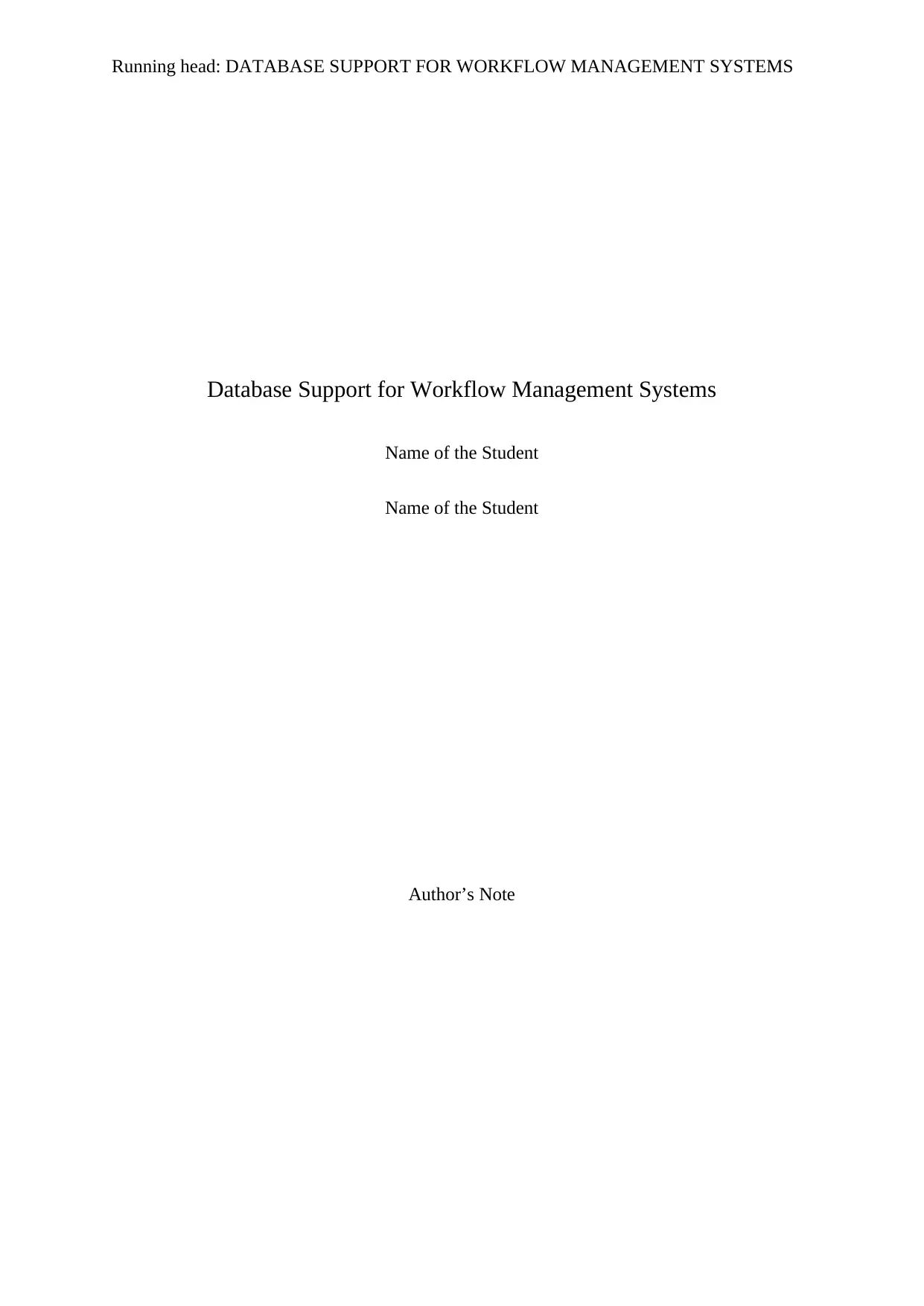
Running head: DATABASE SUPPORT FOR WORKFLOW MANAGEMENT SYSTEMS
Database Support for Workflow Management Systems
Name of the Student
Name of the Student
Author’s Note
Database Support for Workflow Management Systems
Name of the Student
Name of the Student
Author’s Note
Paraphrase This Document
Need a fresh take? Get an instant paraphrase of this document with our AI Paraphraser
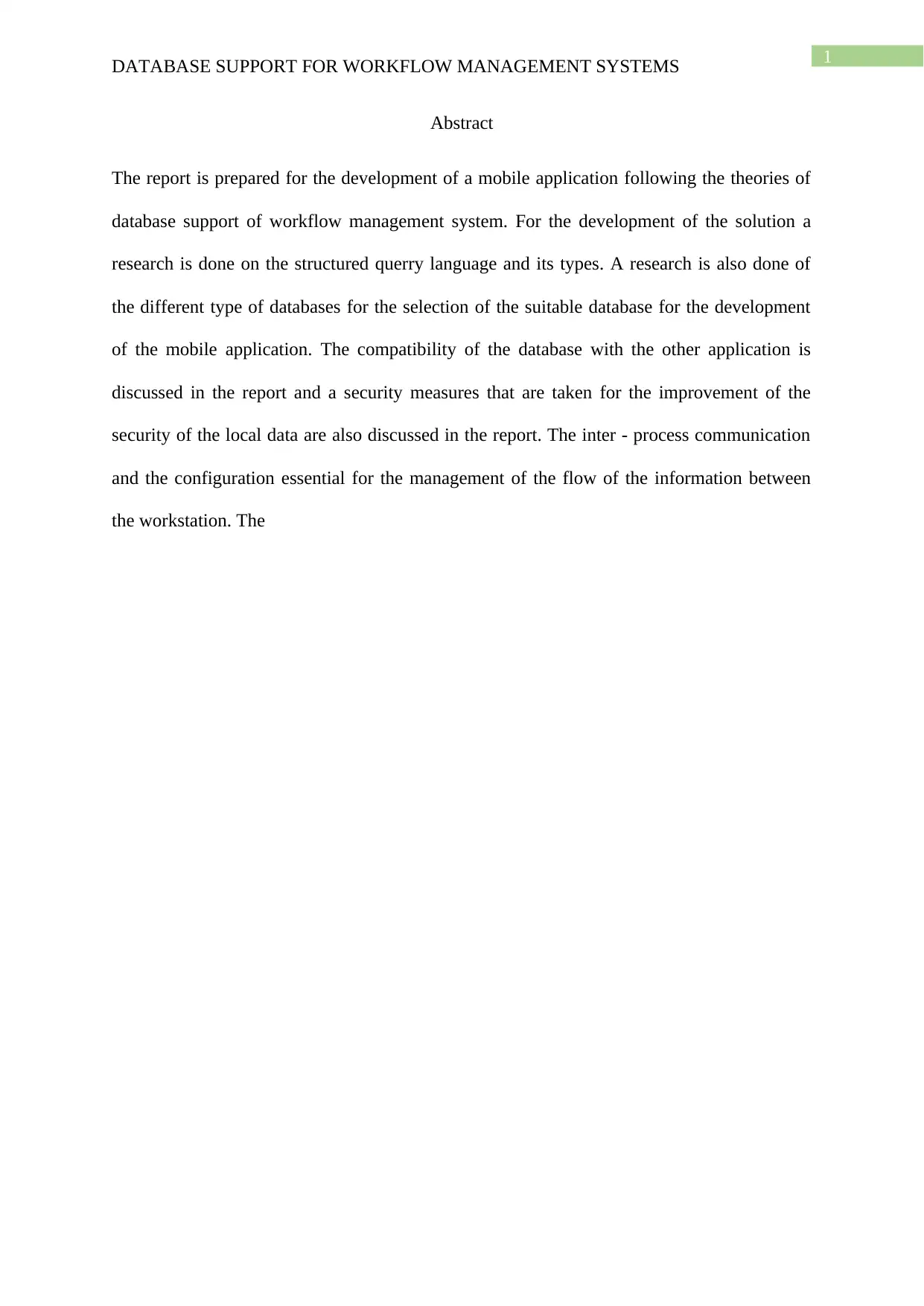
1
DATABASE SUPPORT FOR WORKFLOW MANAGEMENT SYSTEMS
Abstract
The report is prepared for the development of a mobile application following the theories of
database support of workflow management system. For the development of the solution a
research is done on the structured querry language and its types. A research is also done of
the different type of databases for the selection of the suitable database for the development
of the mobile application. The compatibility of the database with the other application is
discussed in the report and a security measures that are taken for the improvement of the
security of the local data are also discussed in the report. The inter - process communication
and the configuration essential for the management of the flow of the information between
the workstation. The
DATABASE SUPPORT FOR WORKFLOW MANAGEMENT SYSTEMS
Abstract
The report is prepared for the development of a mobile application following the theories of
database support of workflow management system. For the development of the solution a
research is done on the structured querry language and its types. A research is also done of
the different type of databases for the selection of the suitable database for the development
of the mobile application. The compatibility of the database with the other application is
discussed in the report and a security measures that are taken for the improvement of the
security of the local data are also discussed in the report. The inter - process communication
and the configuration essential for the management of the flow of the information between
the workstation. The
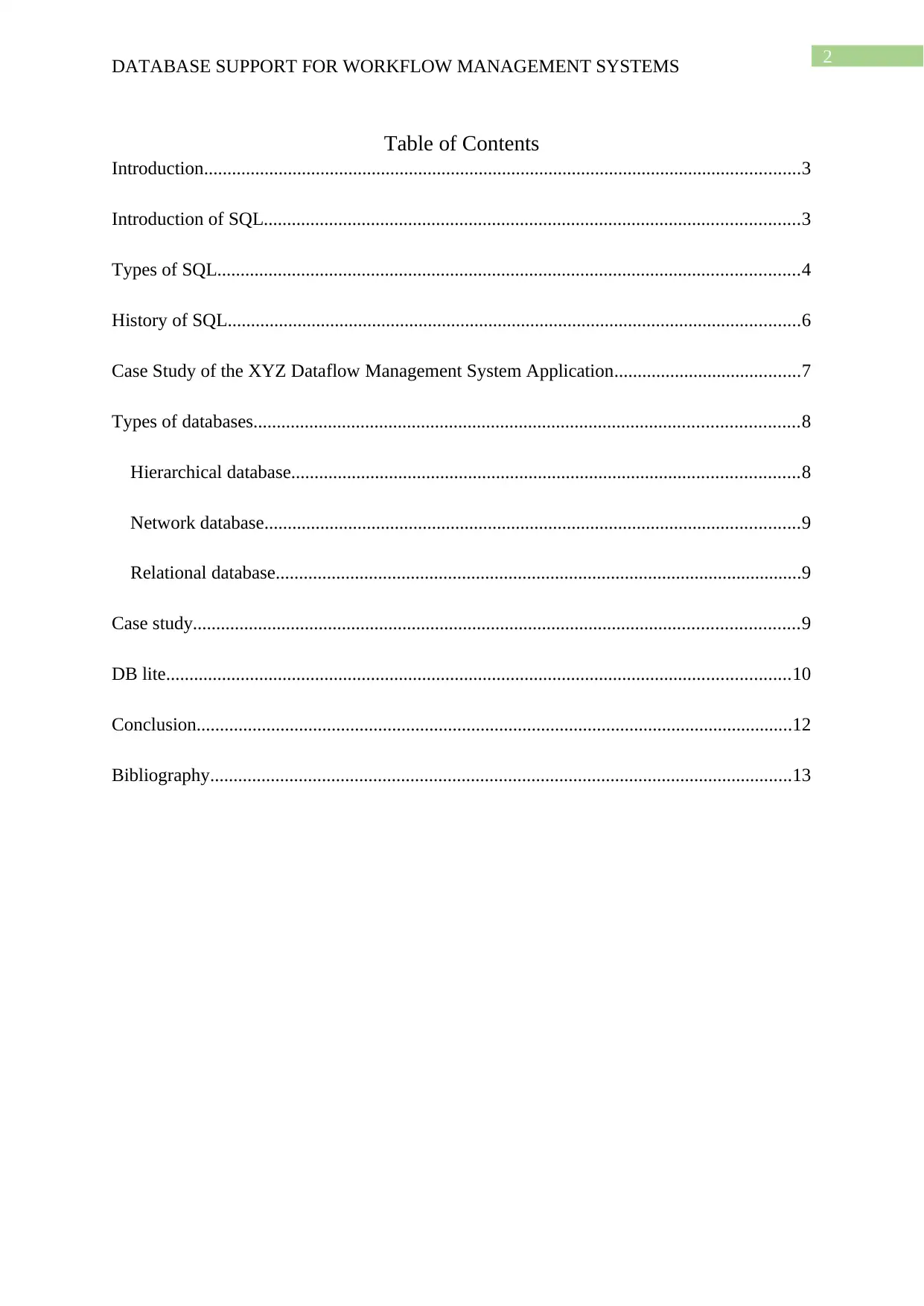
2
DATABASE SUPPORT FOR WORKFLOW MANAGEMENT SYSTEMS
Table of Contents
Introduction................................................................................................................................3
Introduction of SQL...................................................................................................................3
Types of SQL.............................................................................................................................4
History of SQL...........................................................................................................................6
Case Study of the XYZ Dataflow Management System Application........................................7
Types of databases.....................................................................................................................8
Hierarchical database.............................................................................................................8
Network database...................................................................................................................9
Relational database.................................................................................................................9
Case study..................................................................................................................................9
DB lite......................................................................................................................................10
Conclusion................................................................................................................................12
Bibliography.............................................................................................................................13
DATABASE SUPPORT FOR WORKFLOW MANAGEMENT SYSTEMS
Table of Contents
Introduction................................................................................................................................3
Introduction of SQL...................................................................................................................3
Types of SQL.............................................................................................................................4
History of SQL...........................................................................................................................6
Case Study of the XYZ Dataflow Management System Application........................................7
Types of databases.....................................................................................................................8
Hierarchical database.............................................................................................................8
Network database...................................................................................................................9
Relational database.................................................................................................................9
Case study..................................................................................................................................9
DB lite......................................................................................................................................10
Conclusion................................................................................................................................12
Bibliography.............................................................................................................................13
⊘ This is a preview!⊘
Do you want full access?
Subscribe today to unlock all pages.

Trusted by 1+ million students worldwide
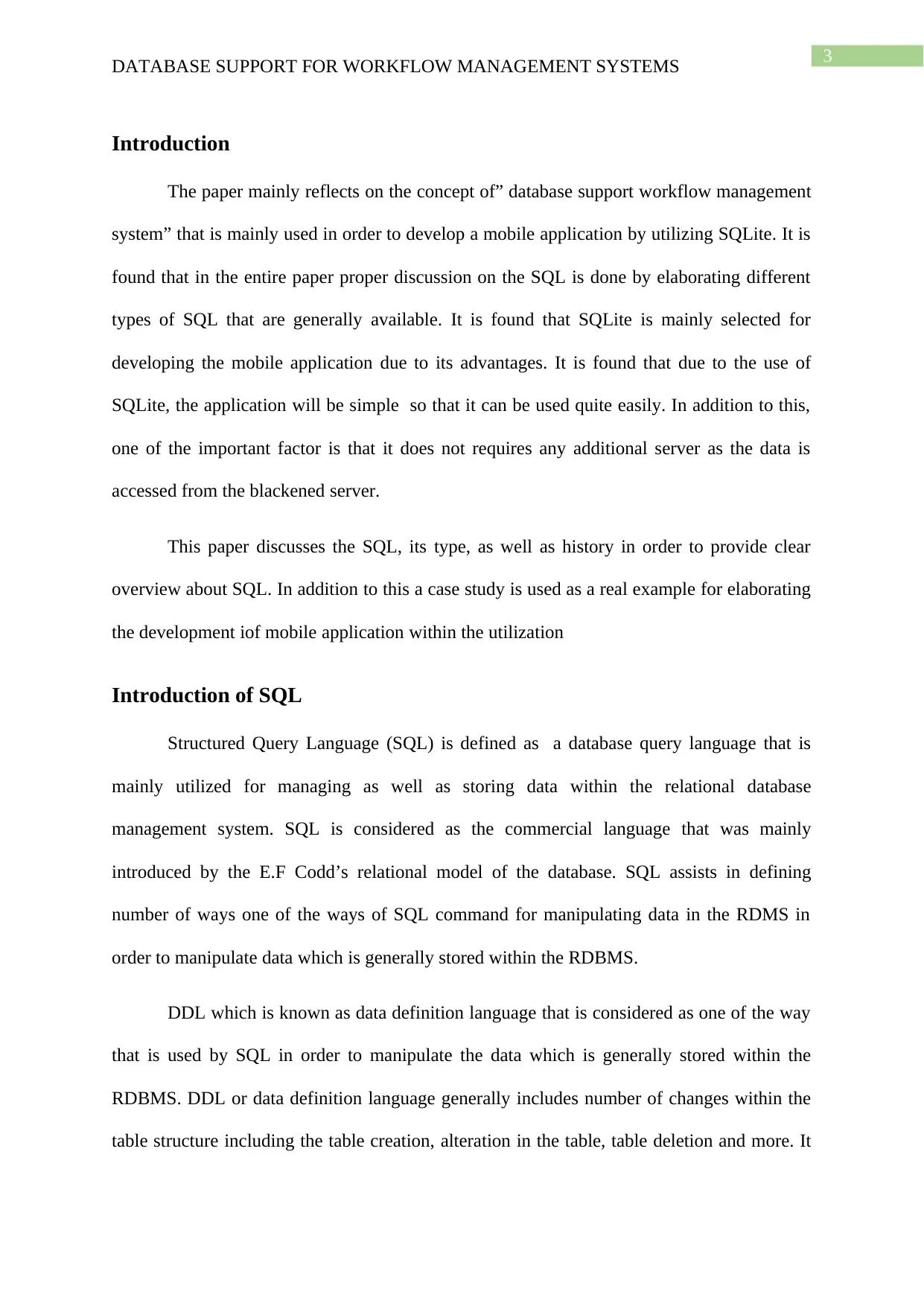
3
DATABASE SUPPORT FOR WORKFLOW MANAGEMENT SYSTEMS
Introduction
The paper mainly reflects on the concept of” database support workflow management
system” that is mainly used in order to develop a mobile application by utilizing SQLite. It is
found that in the entire paper proper discussion on the SQL is done by elaborating different
types of SQL that are generally available. It is found that SQLite is mainly selected for
developing the mobile application due to its advantages. It is found that due to the use of
SQLite, the application will be simple so that it can be used quite easily. In addition to this,
one of the important factor is that it does not requires any additional server as the data is
accessed from the blackened server.
This paper discusses the SQL, its type, as well as history in order to provide clear
overview about SQL. In addition to this a case study is used as a real example for elaborating
the development iof mobile application within the utilization
Introduction of SQL
Structured Query Language (SQL) is defined as a database query language that is
mainly utilized for managing as well as storing data within the relational database
management system. SQL is considered as the commercial language that was mainly
introduced by the E.F Codd’s relational model of the database. SQL assists in defining
number of ways one of the ways of SQL command for manipulating data in the RDMS in
order to manipulate data which is generally stored within the RDBMS.
DDL which is known as data definition language that is considered as one of the way
that is used by SQL in order to manipulate the data which is generally stored within the
RDBMS. DDL or data definition language generally includes number of changes within the
table structure including the table creation, alteration in the table, table deletion and more. It
DATABASE SUPPORT FOR WORKFLOW MANAGEMENT SYSTEMS
Introduction
The paper mainly reflects on the concept of” database support workflow management
system” that is mainly used in order to develop a mobile application by utilizing SQLite. It is
found that in the entire paper proper discussion on the SQL is done by elaborating different
types of SQL that are generally available. It is found that SQLite is mainly selected for
developing the mobile application due to its advantages. It is found that due to the use of
SQLite, the application will be simple so that it can be used quite easily. In addition to this,
one of the important factor is that it does not requires any additional server as the data is
accessed from the blackened server.
This paper discusses the SQL, its type, as well as history in order to provide clear
overview about SQL. In addition to this a case study is used as a real example for elaborating
the development iof mobile application within the utilization
Introduction of SQL
Structured Query Language (SQL) is defined as a database query language that is
mainly utilized for managing as well as storing data within the relational database
management system. SQL is considered as the commercial language that was mainly
introduced by the E.F Codd’s relational model of the database. SQL assists in defining
number of ways one of the ways of SQL command for manipulating data in the RDMS in
order to manipulate data which is generally stored within the RDBMS.
DDL which is known as data definition language that is considered as one of the way
that is used by SQL in order to manipulate the data which is generally stored within the
RDBMS. DDL or data definition language generally includes number of changes within the
table structure including the table creation, alteration in the table, table deletion and more. It
Paraphrase This Document
Need a fresh take? Get an instant paraphrase of this document with our AI Paraphraser
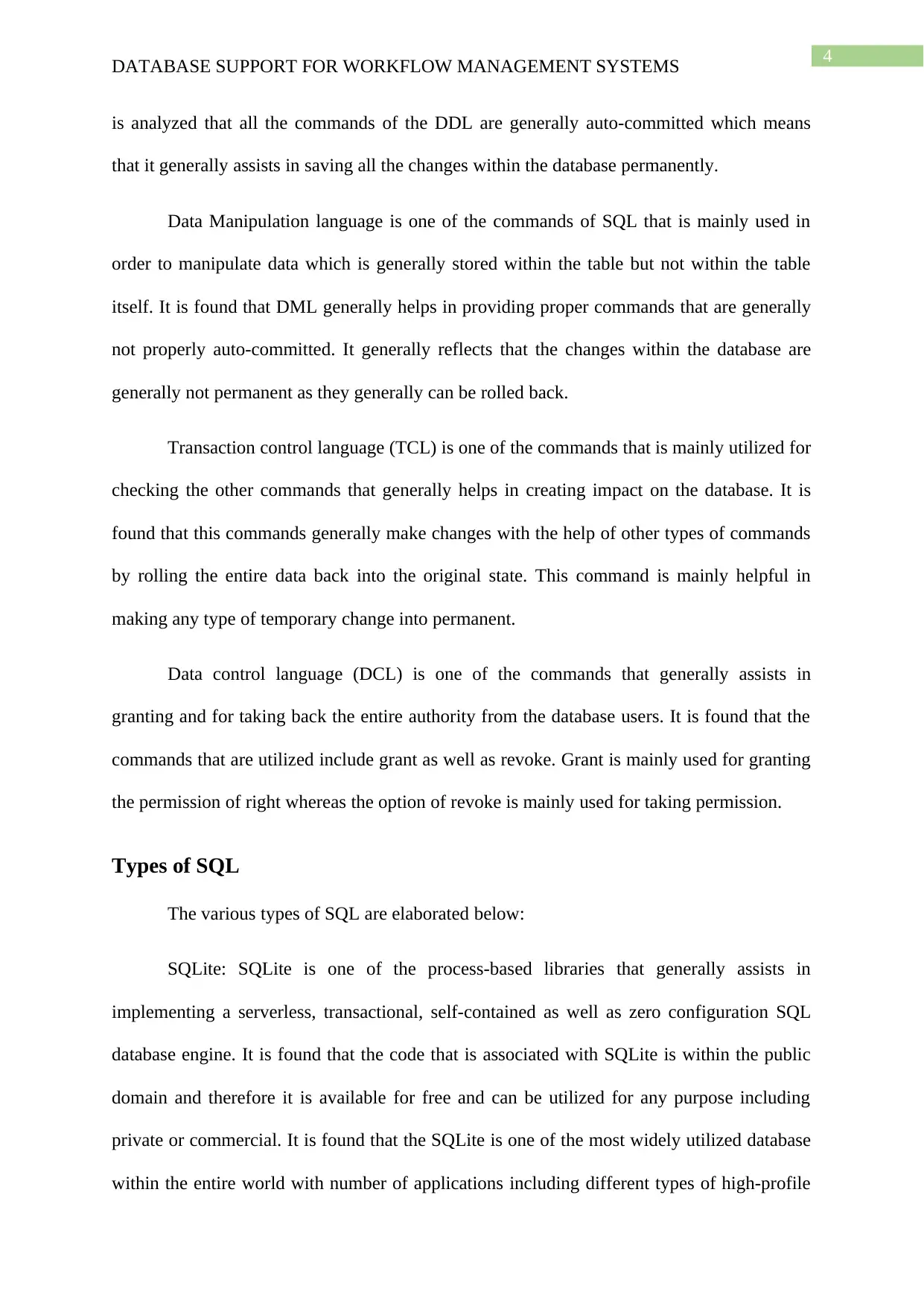
4
DATABASE SUPPORT FOR WORKFLOW MANAGEMENT SYSTEMS
is analyzed that all the commands of the DDL are generally auto-committed which means
that it generally assists in saving all the changes within the database permanently.
Data Manipulation language is one of the commands of SQL that is mainly used in
order to manipulate data which is generally stored within the table but not within the table
itself. It is found that DML generally helps in providing proper commands that are generally
not properly auto-committed. It generally reflects that the changes within the database are
generally not permanent as they generally can be rolled back.
Transaction control language (TCL) is one of the commands that is mainly utilized for
checking the other commands that generally helps in creating impact on the database. It is
found that this commands generally make changes with the help of other types of commands
by rolling the entire data back into the original state. This command is mainly helpful in
making any type of temporary change into permanent.
Data control language (DCL) is one of the commands that generally assists in
granting and for taking back the entire authority from the database users. It is found that the
commands that are utilized include grant as well as revoke. Grant is mainly used for granting
the permission of right whereas the option of revoke is mainly used for taking permission.
Types of SQL
The various types of SQL are elaborated below:
SQLite: SQLite is one of the process-based libraries that generally assists in
implementing a serverless, transactional, self-contained as well as zero configuration SQL
database engine. It is found that the code that is associated with SQLite is within the public
domain and therefore it is available for free and can be utilized for any purpose including
private or commercial. It is found that the SQLite is one of the most widely utilized database
within the entire world with number of applications including different types of high-profile
DATABASE SUPPORT FOR WORKFLOW MANAGEMENT SYSTEMS
is analyzed that all the commands of the DDL are generally auto-committed which means
that it generally assists in saving all the changes within the database permanently.
Data Manipulation language is one of the commands of SQL that is mainly used in
order to manipulate data which is generally stored within the table but not within the table
itself. It is found that DML generally helps in providing proper commands that are generally
not properly auto-committed. It generally reflects that the changes within the database are
generally not permanent as they generally can be rolled back.
Transaction control language (TCL) is one of the commands that is mainly utilized for
checking the other commands that generally helps in creating impact on the database. It is
found that this commands generally make changes with the help of other types of commands
by rolling the entire data back into the original state. This command is mainly helpful in
making any type of temporary change into permanent.
Data control language (DCL) is one of the commands that generally assists in
granting and for taking back the entire authority from the database users. It is found that the
commands that are utilized include grant as well as revoke. Grant is mainly used for granting
the permission of right whereas the option of revoke is mainly used for taking permission.
Types of SQL
The various types of SQL are elaborated below:
SQLite: SQLite is one of the process-based libraries that generally assists in
implementing a serverless, transactional, self-contained as well as zero configuration SQL
database engine. It is found that the code that is associated with SQLite is within the public
domain and therefore it is available for free and can be utilized for any purpose including
private or commercial. It is found that the SQLite is one of the most widely utilized database
within the entire world with number of applications including different types of high-profile
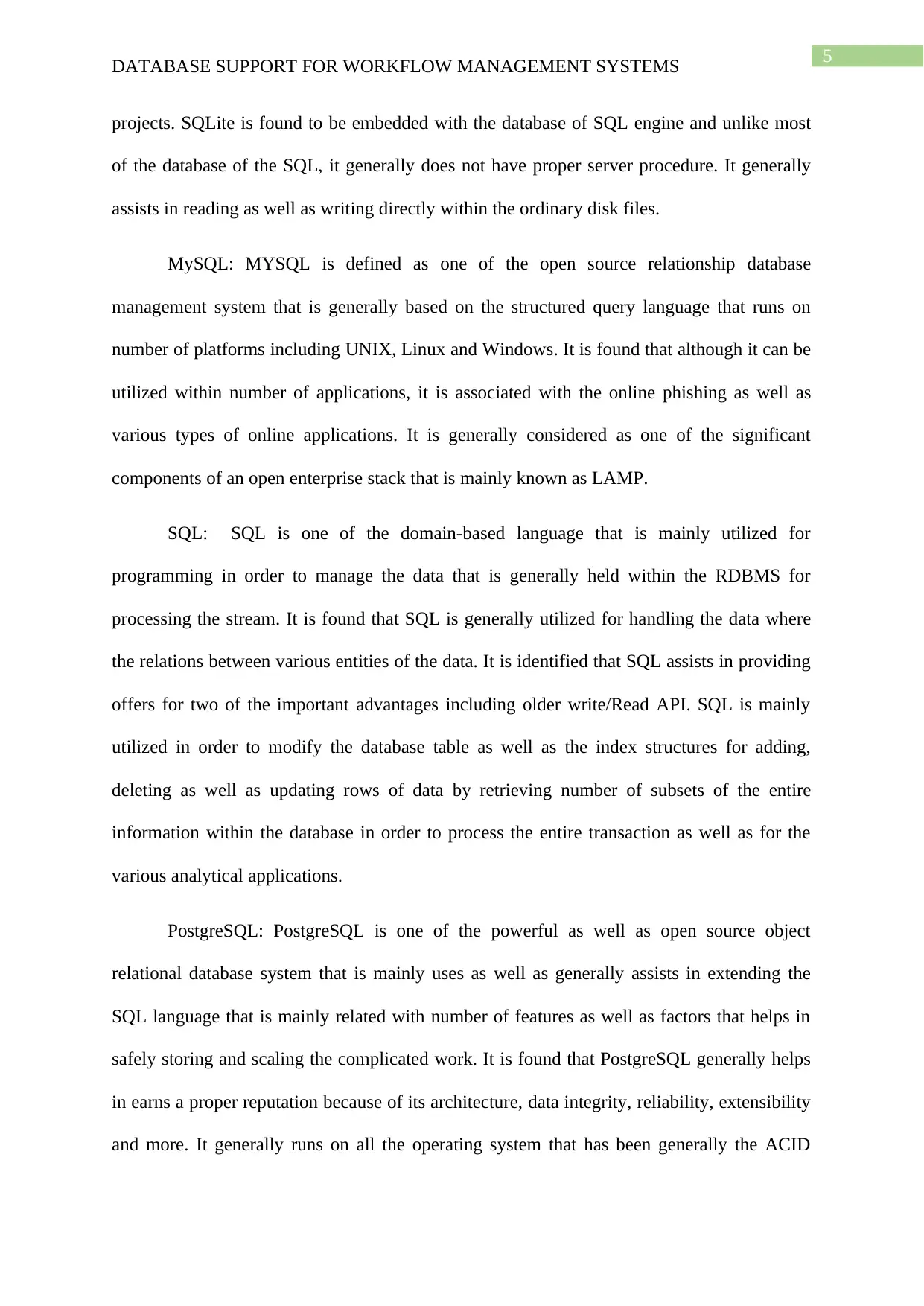
5
DATABASE SUPPORT FOR WORKFLOW MANAGEMENT SYSTEMS
projects. SQLite is found to be embedded with the database of SQL engine and unlike most
of the database of the SQL, it generally does not have proper server procedure. It generally
assists in reading as well as writing directly within the ordinary disk files.
MySQL: MYSQL is defined as one of the open source relationship database
management system that is generally based on the structured query language that runs on
number of platforms including UNIX, Linux and Windows. It is found that although it can be
utilized within number of applications, it is associated with the online phishing as well as
various types of online applications. It is generally considered as one of the significant
components of an open enterprise stack that is mainly known as LAMP.
SQL: SQL is one of the domain-based language that is mainly utilized for
programming in order to manage the data that is generally held within the RDBMS for
processing the stream. It is found that SQL is generally utilized for handling the data where
the relations between various entities of the data. It is identified that SQL assists in providing
offers for two of the important advantages including older write/Read API. SQL is mainly
utilized in order to modify the database table as well as the index structures for adding,
deleting as well as updating rows of data by retrieving number of subsets of the entire
information within the database in order to process the entire transaction as well as for the
various analytical applications.
PostgreSQL: PostgreSQL is one of the powerful as well as open source object
relational database system that is mainly uses as well as generally assists in extending the
SQL language that is mainly related with number of features as well as factors that helps in
safely storing and scaling the complicated work. It is found that PostgreSQL generally helps
in earns a proper reputation because of its architecture, data integrity, reliability, extensibility
and more. It generally runs on all the operating system that has been generally the ACID
DATABASE SUPPORT FOR WORKFLOW MANAGEMENT SYSTEMS
projects. SQLite is found to be embedded with the database of SQL engine and unlike most
of the database of the SQL, it generally does not have proper server procedure. It generally
assists in reading as well as writing directly within the ordinary disk files.
MySQL: MYSQL is defined as one of the open source relationship database
management system that is generally based on the structured query language that runs on
number of platforms including UNIX, Linux and Windows. It is found that although it can be
utilized within number of applications, it is associated with the online phishing as well as
various types of online applications. It is generally considered as one of the significant
components of an open enterprise stack that is mainly known as LAMP.
SQL: SQL is one of the domain-based language that is mainly utilized for
programming in order to manage the data that is generally held within the RDBMS for
processing the stream. It is found that SQL is generally utilized for handling the data where
the relations between various entities of the data. It is identified that SQL assists in providing
offers for two of the important advantages including older write/Read API. SQL is mainly
utilized in order to modify the database table as well as the index structures for adding,
deleting as well as updating rows of data by retrieving number of subsets of the entire
information within the database in order to process the entire transaction as well as for the
various analytical applications.
PostgreSQL: PostgreSQL is one of the powerful as well as open source object
relational database system that is mainly uses as well as generally assists in extending the
SQL language that is mainly related with number of features as well as factors that helps in
safely storing and scaling the complicated work. It is found that PostgreSQL generally helps
in earns a proper reputation because of its architecture, data integrity, reliability, extensibility
and more. It generally runs on all the operating system that has been generally the ACID
⊘ This is a preview!⊘
Do you want full access?
Subscribe today to unlock all pages.

Trusted by 1+ million students worldwide
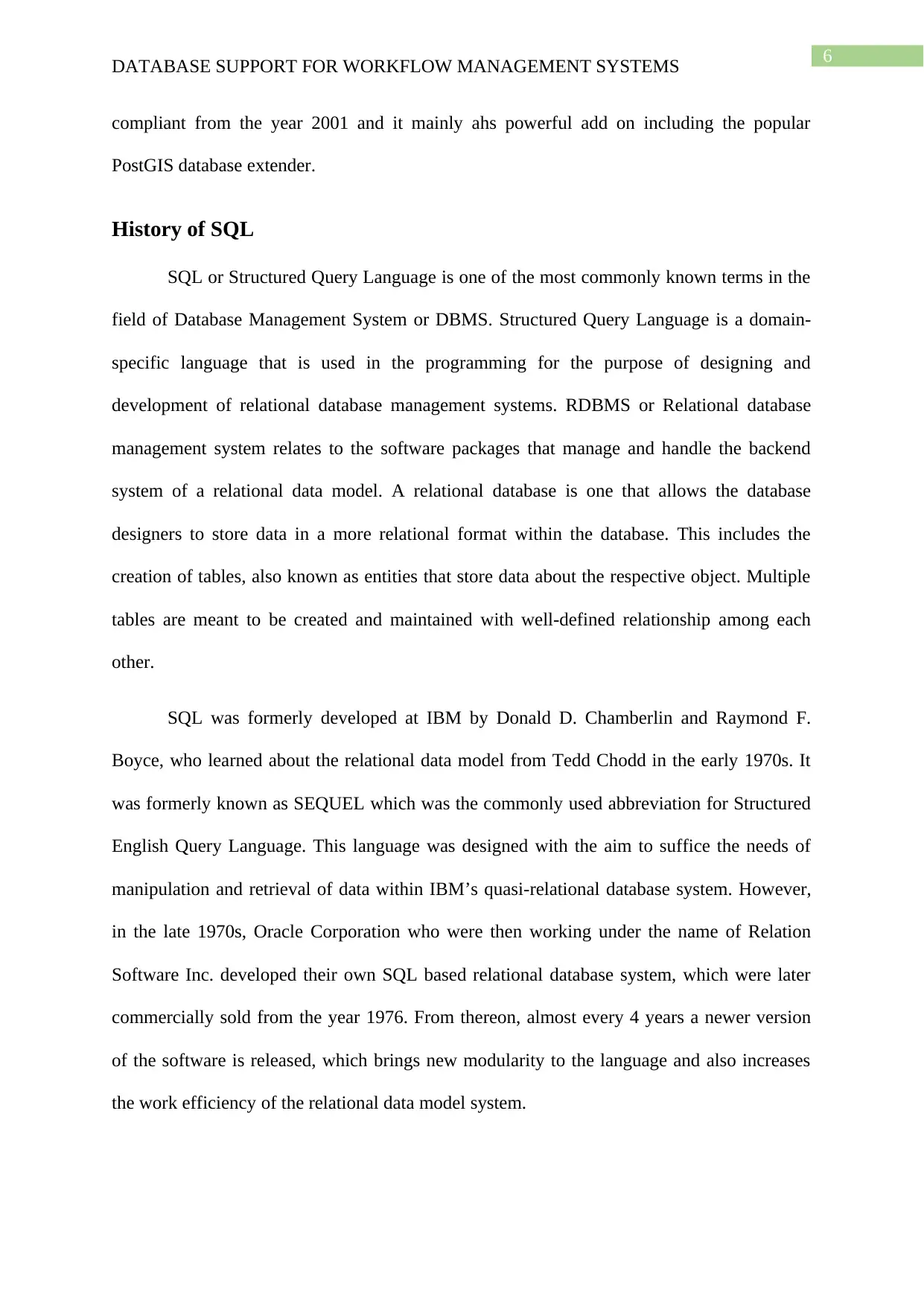
6
DATABASE SUPPORT FOR WORKFLOW MANAGEMENT SYSTEMS
compliant from the year 2001 and it mainly ahs powerful add on including the popular
PostGIS database extender.
History of SQL
SQL or Structured Query Language is one of the most commonly known terms in the
field of Database Management System or DBMS. Structured Query Language is a domain-
specific language that is used in the programming for the purpose of designing and
development of relational database management systems. RDBMS or Relational database
management system relates to the software packages that manage and handle the backend
system of a relational data model. A relational database is one that allows the database
designers to store data in a more relational format within the database. This includes the
creation of tables, also known as entities that store data about the respective object. Multiple
tables are meant to be created and maintained with well-defined relationship among each
other.
SQL was formerly developed at IBM by Donald D. Chamberlin and Raymond F.
Boyce, who learned about the relational data model from Tedd Chodd in the early 1970s. It
was formerly known as SEQUEL which was the commonly used abbreviation for Structured
English Query Language. This language was designed with the aim to suffice the needs of
manipulation and retrieval of data within IBM’s quasi-relational database system. However,
in the late 1970s, Oracle Corporation who were then working under the name of Relation
Software Inc. developed their own SQL based relational database system, which were later
commercially sold from the year 1976. From thereon, almost every 4 years a newer version
of the software is released, which brings new modularity to the language and also increases
the work efficiency of the relational data model system.
DATABASE SUPPORT FOR WORKFLOW MANAGEMENT SYSTEMS
compliant from the year 2001 and it mainly ahs powerful add on including the popular
PostGIS database extender.
History of SQL
SQL or Structured Query Language is one of the most commonly known terms in the
field of Database Management System or DBMS. Structured Query Language is a domain-
specific language that is used in the programming for the purpose of designing and
development of relational database management systems. RDBMS or Relational database
management system relates to the software packages that manage and handle the backend
system of a relational data model. A relational database is one that allows the database
designers to store data in a more relational format within the database. This includes the
creation of tables, also known as entities that store data about the respective object. Multiple
tables are meant to be created and maintained with well-defined relationship among each
other.
SQL was formerly developed at IBM by Donald D. Chamberlin and Raymond F.
Boyce, who learned about the relational data model from Tedd Chodd in the early 1970s. It
was formerly known as SEQUEL which was the commonly used abbreviation for Structured
English Query Language. This language was designed with the aim to suffice the needs of
manipulation and retrieval of data within IBM’s quasi-relational database system. However,
in the late 1970s, Oracle Corporation who were then working under the name of Relation
Software Inc. developed their own SQL based relational database system, which were later
commercially sold from the year 1976. From thereon, almost every 4 years a newer version
of the software is released, which brings new modularity to the language and also increases
the work efficiency of the relational data model system.
Paraphrase This Document
Need a fresh take? Get an instant paraphrase of this document with our AI Paraphraser
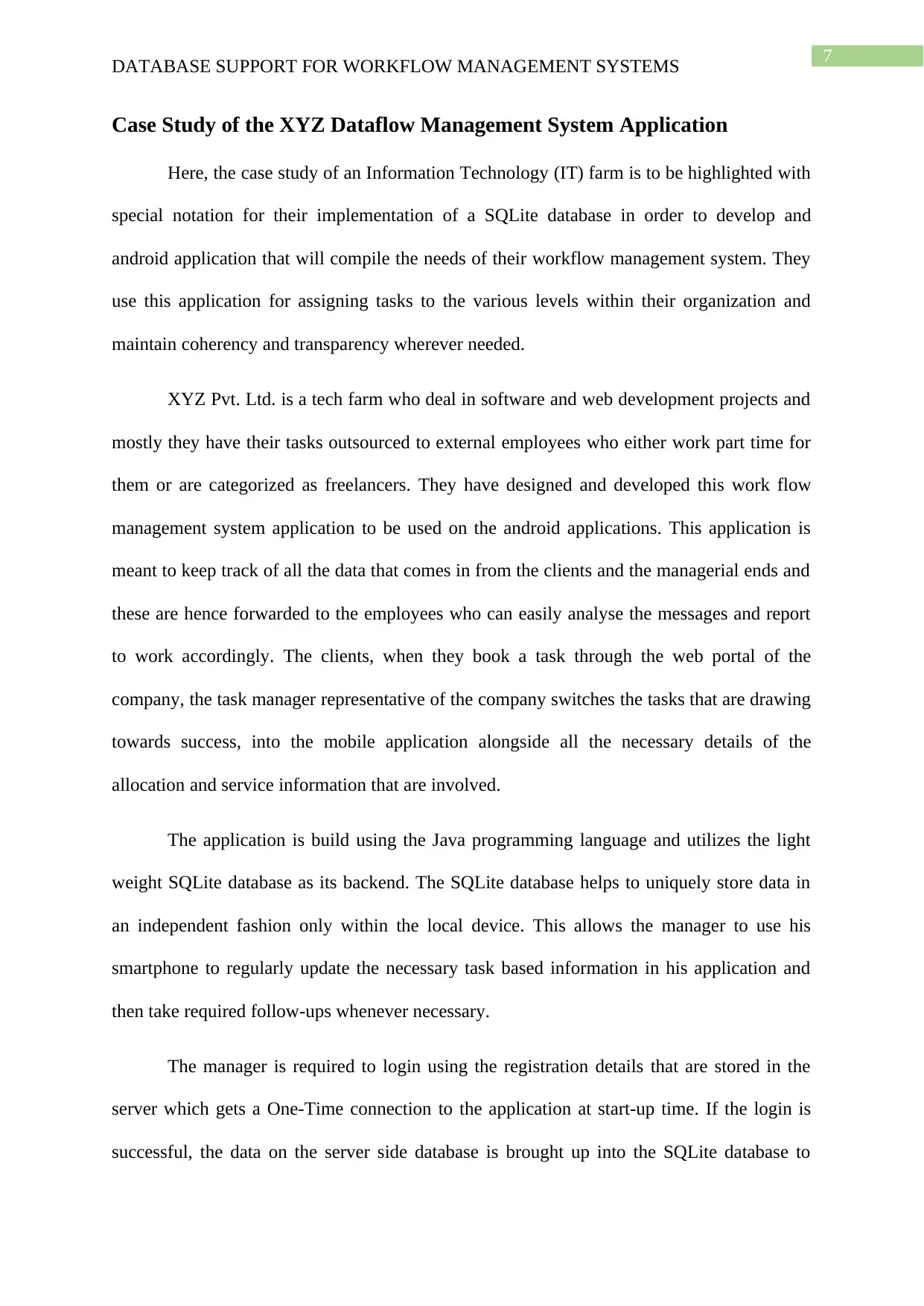
7
DATABASE SUPPORT FOR WORKFLOW MANAGEMENT SYSTEMS
Case Study of the XYZ Dataflow Management System Application
Here, the case study of an Information Technology (IT) farm is to be highlighted with
special notation for their implementation of a SQLite database in order to develop and
android application that will compile the needs of their workflow management system. They
use this application for assigning tasks to the various levels within their organization and
maintain coherency and transparency wherever needed.
XYZ Pvt. Ltd. is a tech farm who deal in software and web development projects and
mostly they have their tasks outsourced to external employees who either work part time for
them or are categorized as freelancers. They have designed and developed this work flow
management system application to be used on the android applications. This application is
meant to keep track of all the data that comes in from the clients and the managerial ends and
these are hence forwarded to the employees who can easily analyse the messages and report
to work accordingly. The clients, when they book a task through the web portal of the
company, the task manager representative of the company switches the tasks that are drawing
towards success, into the mobile application alongside all the necessary details of the
allocation and service information that are involved.
The application is build using the Java programming language and utilizes the light
weight SQLite database as its backend. The SQLite database helps to uniquely store data in
an independent fashion only within the local device. This allows the manager to use his
smartphone to regularly update the necessary task based information in his application and
then take required follow-ups whenever necessary.
The manager is required to login using the registration details that are stored in the
server which gets a One-Time connection to the application at start-up time. If the login is
successful, the data on the server side database is brought up into the SQLite database to
DATABASE SUPPORT FOR WORKFLOW MANAGEMENT SYSTEMS
Case Study of the XYZ Dataflow Management System Application
Here, the case study of an Information Technology (IT) farm is to be highlighted with
special notation for their implementation of a SQLite database in order to develop and
android application that will compile the needs of their workflow management system. They
use this application for assigning tasks to the various levels within their organization and
maintain coherency and transparency wherever needed.
XYZ Pvt. Ltd. is a tech farm who deal in software and web development projects and
mostly they have their tasks outsourced to external employees who either work part time for
them or are categorized as freelancers. They have designed and developed this work flow
management system application to be used on the android applications. This application is
meant to keep track of all the data that comes in from the clients and the managerial ends and
these are hence forwarded to the employees who can easily analyse the messages and report
to work accordingly. The clients, when they book a task through the web portal of the
company, the task manager representative of the company switches the tasks that are drawing
towards success, into the mobile application alongside all the necessary details of the
allocation and service information that are involved.
The application is build using the Java programming language and utilizes the light
weight SQLite database as its backend. The SQLite database helps to uniquely store data in
an independent fashion only within the local device. This allows the manager to use his
smartphone to regularly update the necessary task based information in his application and
then take required follow-ups whenever necessary.
The manager is required to login using the registration details that are stored in the
server which gets a One-Time connection to the application at start-up time. If the login is
successful, the data on the server side database is brought up into the SQLite database to
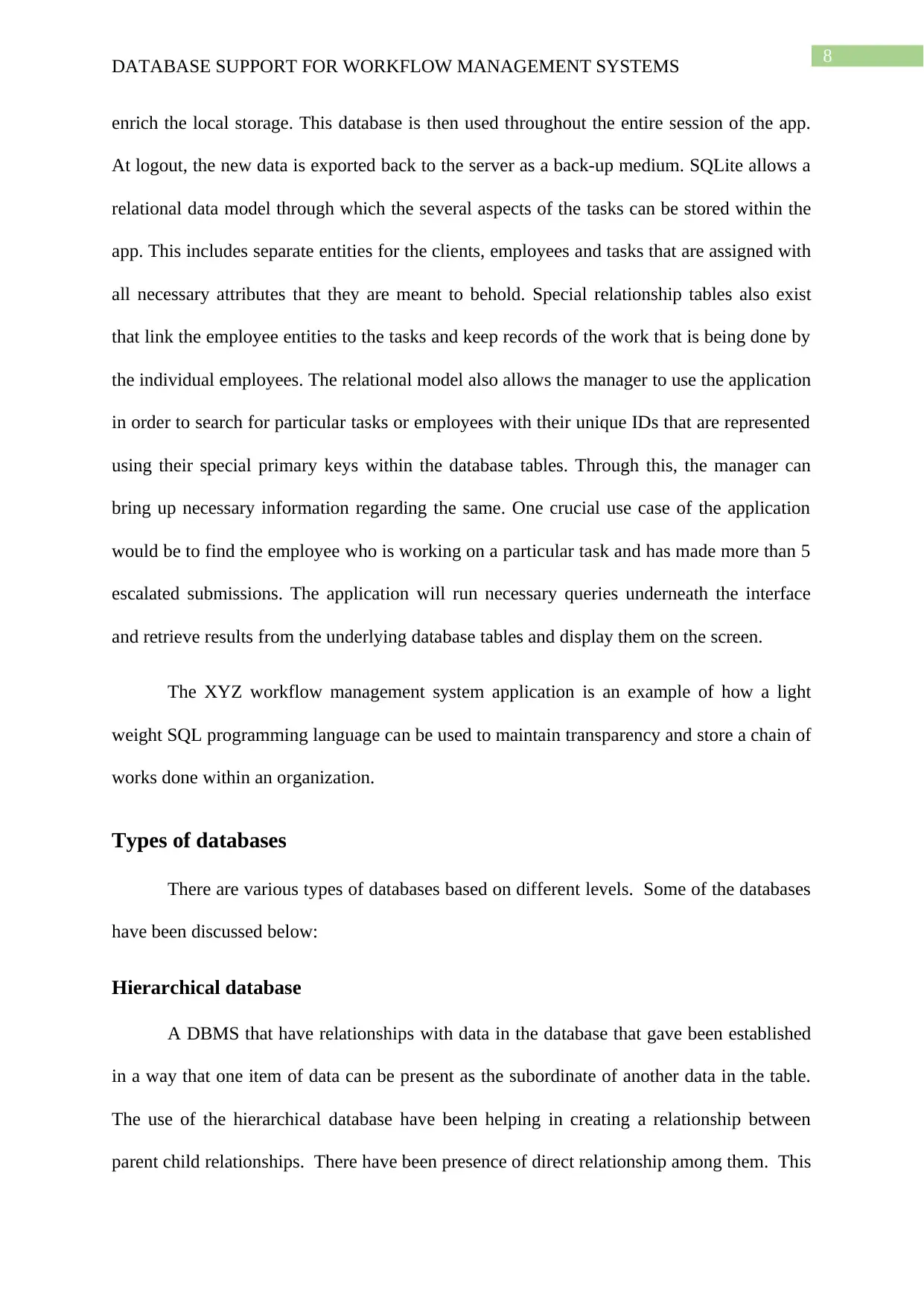
8
DATABASE SUPPORT FOR WORKFLOW MANAGEMENT SYSTEMS
enrich the local storage. This database is then used throughout the entire session of the app.
At logout, the new data is exported back to the server as a back-up medium. SQLite allows a
relational data model through which the several aspects of the tasks can be stored within the
app. This includes separate entities for the clients, employees and tasks that are assigned with
all necessary attributes that they are meant to behold. Special relationship tables also exist
that link the employee entities to the tasks and keep records of the work that is being done by
the individual employees. The relational model also allows the manager to use the application
in order to search for particular tasks or employees with their unique IDs that are represented
using their special primary keys within the database tables. Through this, the manager can
bring up necessary information regarding the same. One crucial use case of the application
would be to find the employee who is working on a particular task and has made more than 5
escalated submissions. The application will run necessary queries underneath the interface
and retrieve results from the underlying database tables and display them on the screen.
The XYZ workflow management system application is an example of how a light
weight SQL programming language can be used to maintain transparency and store a chain of
works done within an organization.
Types of databases
There are various types of databases based on different levels. Some of the databases
have been discussed below:
Hierarchical database
A DBMS that have relationships with data in the database that gave been established
in a way that one item of data can be present as the subordinate of another data in the table.
The use of the hierarchical database have been helping in creating a relationship between
parent child relationships. There have been presence of direct relationship among them. This
DATABASE SUPPORT FOR WORKFLOW MANAGEMENT SYSTEMS
enrich the local storage. This database is then used throughout the entire session of the app.
At logout, the new data is exported back to the server as a back-up medium. SQLite allows a
relational data model through which the several aspects of the tasks can be stored within the
app. This includes separate entities for the clients, employees and tasks that are assigned with
all necessary attributes that they are meant to behold. Special relationship tables also exist
that link the employee entities to the tasks and keep records of the work that is being done by
the individual employees. The relational model also allows the manager to use the application
in order to search for particular tasks or employees with their unique IDs that are represented
using their special primary keys within the database tables. Through this, the manager can
bring up necessary information regarding the same. One crucial use case of the application
would be to find the employee who is working on a particular task and has made more than 5
escalated submissions. The application will run necessary queries underneath the interface
and retrieve results from the underlying database tables and display them on the screen.
The XYZ workflow management system application is an example of how a light
weight SQL programming language can be used to maintain transparency and store a chain of
works done within an organization.
Types of databases
There are various types of databases based on different levels. Some of the databases
have been discussed below:
Hierarchical database
A DBMS that have relationships with data in the database that gave been established
in a way that one item of data can be present as the subordinate of another data in the table.
The use of the hierarchical database have been helping in creating a relationship between
parent child relationships. There have been presence of direct relationship among them. This
⊘ This is a preview!⊘
Do you want full access?
Subscribe today to unlock all pages.

Trusted by 1+ million students worldwide
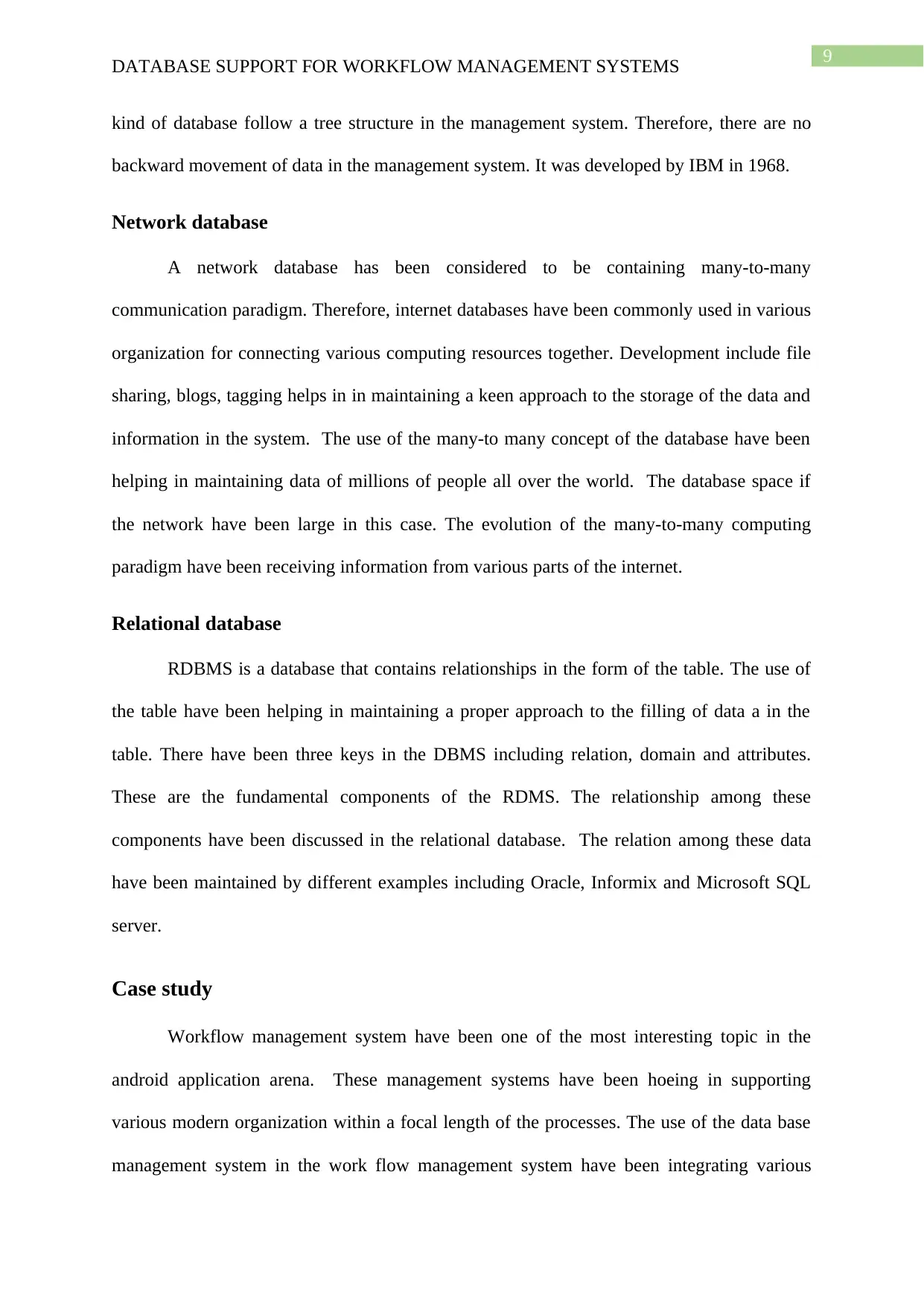
9
DATABASE SUPPORT FOR WORKFLOW MANAGEMENT SYSTEMS
kind of database follow a tree structure in the management system. Therefore, there are no
backward movement of data in the management system. It was developed by IBM in 1968.
Network database
A network database has been considered to be containing many-to-many
communication paradigm. Therefore, internet databases have been commonly used in various
organization for connecting various computing resources together. Development include file
sharing, blogs, tagging helps in in maintaining a keen approach to the storage of the data and
information in the system. The use of the many-to many concept of the database have been
helping in maintaining data of millions of people all over the world. The database space if
the network have been large in this case. The evolution of the many-to-many computing
paradigm have been receiving information from various parts of the internet.
Relational database
RDBMS is a database that contains relationships in the form of the table. The use of
the table have been helping in maintaining a proper approach to the filling of data a in the
table. There have been three keys in the DBMS including relation, domain and attributes.
These are the fundamental components of the RDMS. The relationship among these
components have been discussed in the relational database. The relation among these data
have been maintained by different examples including Oracle, Informix and Microsoft SQL
server.
Case study
Workflow management system have been one of the most interesting topic in the
android application arena. These management systems have been hoeing in supporting
various modern organization within a focal length of the processes. The use of the data base
management system in the work flow management system have been integrating various
DATABASE SUPPORT FOR WORKFLOW MANAGEMENT SYSTEMS
kind of database follow a tree structure in the management system. Therefore, there are no
backward movement of data in the management system. It was developed by IBM in 1968.
Network database
A network database has been considered to be containing many-to-many
communication paradigm. Therefore, internet databases have been commonly used in various
organization for connecting various computing resources together. Development include file
sharing, blogs, tagging helps in in maintaining a keen approach to the storage of the data and
information in the system. The use of the many-to many concept of the database have been
helping in maintaining data of millions of people all over the world. The database space if
the network have been large in this case. The evolution of the many-to-many computing
paradigm have been receiving information from various parts of the internet.
Relational database
RDBMS is a database that contains relationships in the form of the table. The use of
the table have been helping in maintaining a proper approach to the filling of data a in the
table. There have been three keys in the DBMS including relation, domain and attributes.
These are the fundamental components of the RDMS. The relationship among these
components have been discussed in the relational database. The relation among these data
have been maintained by different examples including Oracle, Informix and Microsoft SQL
server.
Case study
Workflow management system have been one of the most interesting topic in the
android application arena. These management systems have been hoeing in supporting
various modern organization within a focal length of the processes. The use of the data base
management system in the work flow management system have been integrating various
Paraphrase This Document
Need a fresh take? Get an instant paraphrase of this document with our AI Paraphraser
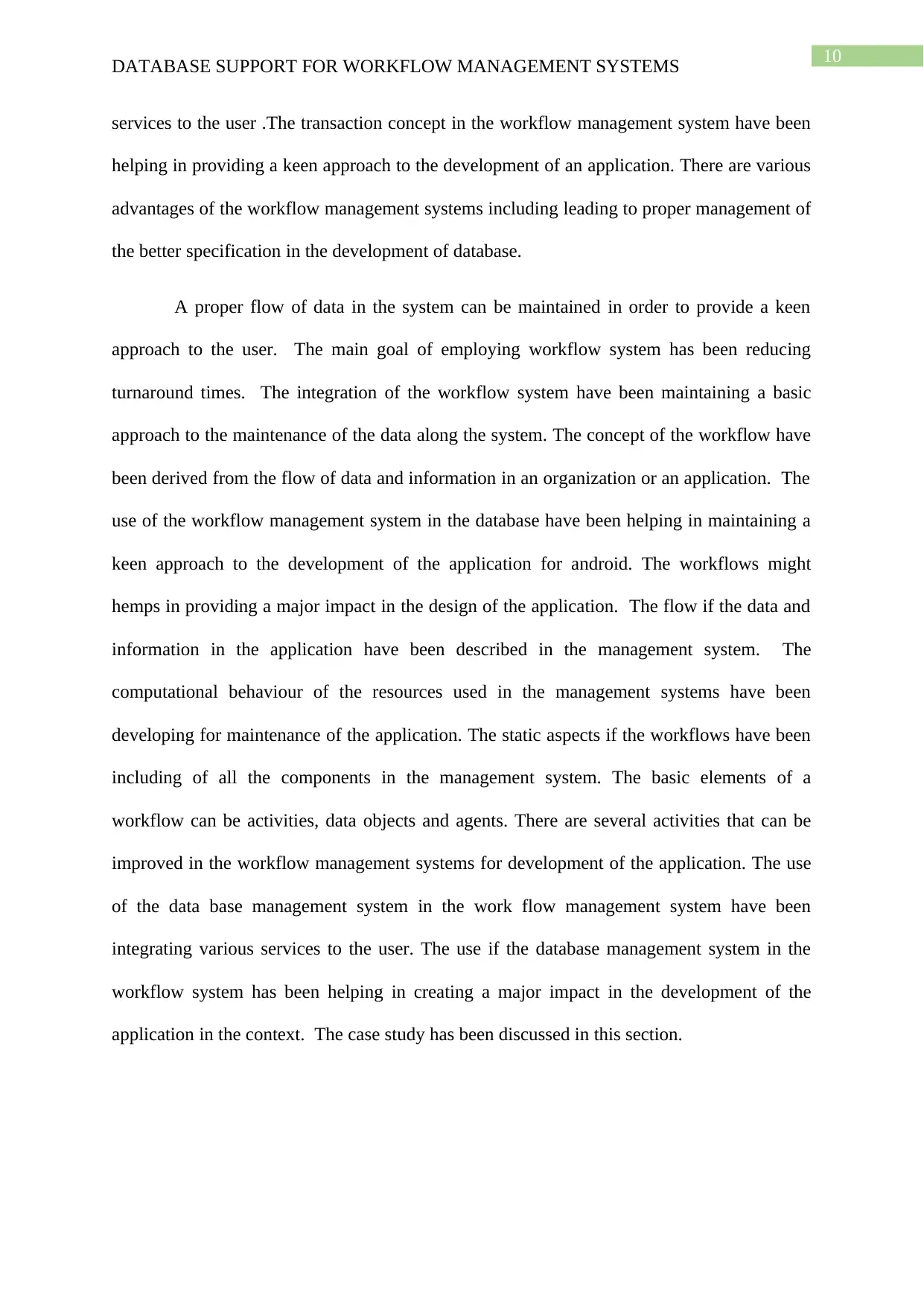
10
DATABASE SUPPORT FOR WORKFLOW MANAGEMENT SYSTEMS
services to the user .The transaction concept in the workflow management system have been
helping in providing a keen approach to the development of an application. There are various
advantages of the workflow management systems including leading to proper management of
the better specification in the development of database.
A proper flow of data in the system can be maintained in order to provide a keen
approach to the user. The main goal of employing workflow system has been reducing
turnaround times. The integration of the workflow system have been maintaining a basic
approach to the maintenance of the data along the system. The concept of the workflow have
been derived from the flow of data and information in an organization or an application. The
use of the workflow management system in the database have been helping in maintaining a
keen approach to the development of the application for android. The workflows might
hemps in providing a major impact in the design of the application. The flow if the data and
information in the application have been described in the management system. The
computational behaviour of the resources used in the management systems have been
developing for maintenance of the application. The static aspects if the workflows have been
including of all the components in the management system. The basic elements of a
workflow can be activities, data objects and agents. There are several activities that can be
improved in the workflow management systems for development of the application. The use
of the data base management system in the work flow management system have been
integrating various services to the user. The use if the database management system in the
workflow system has been helping in creating a major impact in the development of the
application in the context. The case study has been discussed in this section.
DATABASE SUPPORT FOR WORKFLOW MANAGEMENT SYSTEMS
services to the user .The transaction concept in the workflow management system have been
helping in providing a keen approach to the development of an application. There are various
advantages of the workflow management systems including leading to proper management of
the better specification in the development of database.
A proper flow of data in the system can be maintained in order to provide a keen
approach to the user. The main goal of employing workflow system has been reducing
turnaround times. The integration of the workflow system have been maintaining a basic
approach to the maintenance of the data along the system. The concept of the workflow have
been derived from the flow of data and information in an organization or an application. The
use of the workflow management system in the database have been helping in maintaining a
keen approach to the development of the application for android. The workflows might
hemps in providing a major impact in the design of the application. The flow if the data and
information in the application have been described in the management system. The
computational behaviour of the resources used in the management systems have been
developing for maintenance of the application. The static aspects if the workflows have been
including of all the components in the management system. The basic elements of a
workflow can be activities, data objects and agents. There are several activities that can be
improved in the workflow management systems for development of the application. The use
of the data base management system in the work flow management system have been
integrating various services to the user. The use if the database management system in the
workflow system has been helping in creating a major impact in the development of the
application in the context. The case study has been discussed in this section.
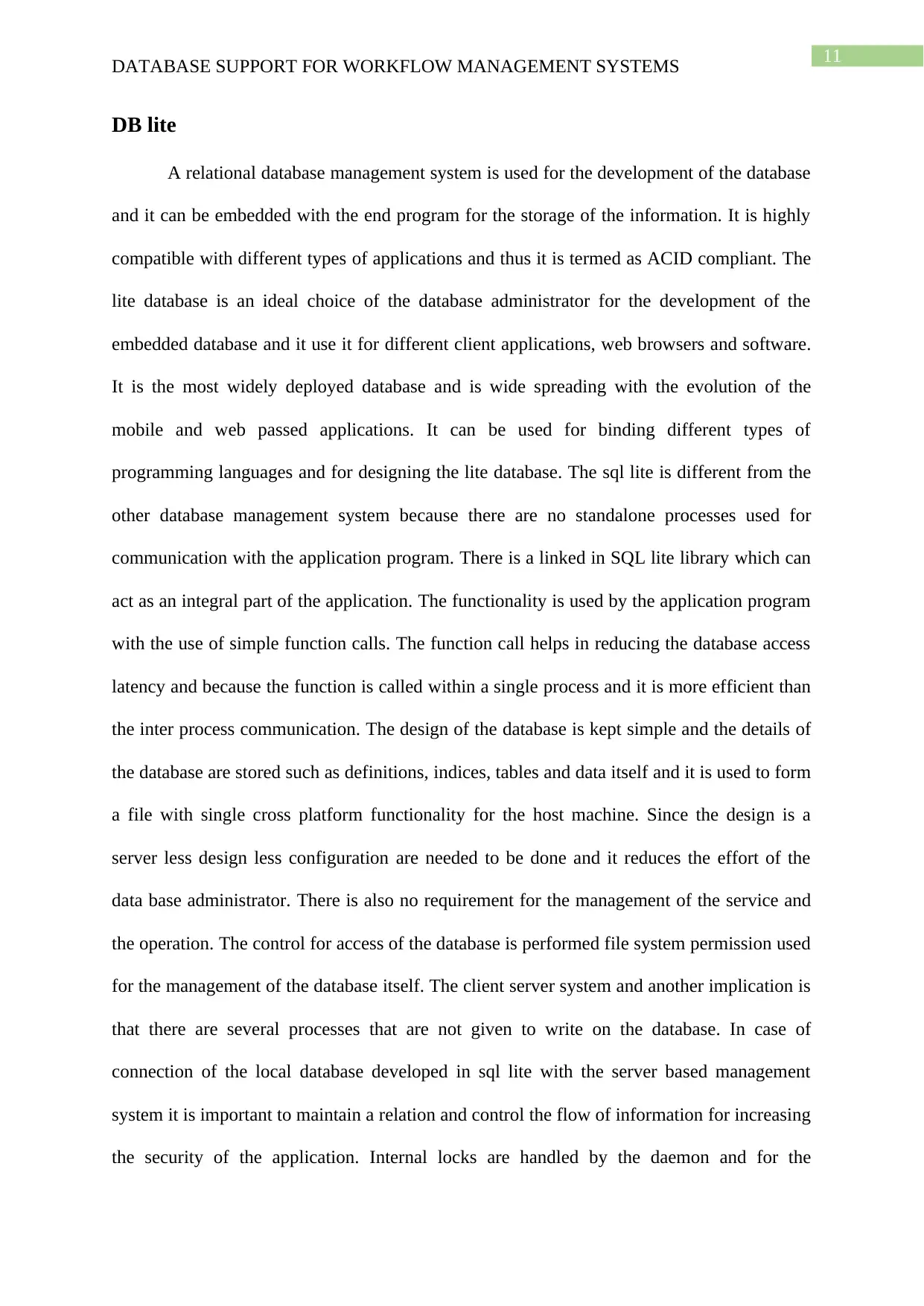
11
DATABASE SUPPORT FOR WORKFLOW MANAGEMENT SYSTEMS
DB lite
A relational database management system is used for the development of the database
and it can be embedded with the end program for the storage of the information. It is highly
compatible with different types of applications and thus it is termed as ACID compliant. The
lite database is an ideal choice of the database administrator for the development of the
embedded database and it use it for different client applications, web browsers and software.
It is the most widely deployed database and is wide spreading with the evolution of the
mobile and web passed applications. It can be used for binding different types of
programming languages and for designing the lite database. The sql lite is different from the
other database management system because there are no standalone processes used for
communication with the application program. There is a linked in SQL lite library which can
act as an integral part of the application. The functionality is used by the application program
with the use of simple function calls. The function call helps in reducing the database access
latency and because the function is called within a single process and it is more efficient than
the inter process communication. The design of the database is kept simple and the details of
the database are stored such as definitions, indices, tables and data itself and it is used to form
a file with single cross platform functionality for the host machine. Since the design is a
server less design less configuration are needed to be done and it reduces the effort of the
data base administrator. There is also no requirement for the management of the service and
the operation. The control for access of the database is performed file system permission used
for the management of the database itself. The client server system and another implication is
that there are several processes that are not given to write on the database. In case of
connection of the local database developed in sql lite with the server based management
system it is important to maintain a relation and control the flow of information for increasing
the security of the application. Internal locks are handled by the daemon and for the
DATABASE SUPPORT FOR WORKFLOW MANAGEMENT SYSTEMS
DB lite
A relational database management system is used for the development of the database
and it can be embedded with the end program for the storage of the information. It is highly
compatible with different types of applications and thus it is termed as ACID compliant. The
lite database is an ideal choice of the database administrator for the development of the
embedded database and it use it for different client applications, web browsers and software.
It is the most widely deployed database and is wide spreading with the evolution of the
mobile and web passed applications. It can be used for binding different types of
programming languages and for designing the lite database. The sql lite is different from the
other database management system because there are no standalone processes used for
communication with the application program. There is a linked in SQL lite library which can
act as an integral part of the application. The functionality is used by the application program
with the use of simple function calls. The function call helps in reducing the database access
latency and because the function is called within a single process and it is more efficient than
the inter process communication. The design of the database is kept simple and the details of
the database are stored such as definitions, indices, tables and data itself and it is used to form
a file with single cross platform functionality for the host machine. Since the design is a
server less design less configuration are needed to be done and it reduces the effort of the
data base administrator. There is also no requirement for the management of the service and
the operation. The control for access of the database is performed file system permission used
for the management of the database itself. The client server system and another implication is
that there are several processes that are not given to write on the database. In case of
connection of the local database developed in sql lite with the server based management
system it is important to maintain a relation and control the flow of information for increasing
the security of the application. Internal locks are handled by the daemon and for the
⊘ This is a preview!⊘
Do you want full access?
Subscribe today to unlock all pages.

Trusted by 1+ million students worldwide
1 out of 18
Related Documents
Your All-in-One AI-Powered Toolkit for Academic Success.
+13062052269
info@desklib.com
Available 24*7 on WhatsApp / Email
![[object Object]](/_next/static/media/star-bottom.7253800d.svg)
Unlock your academic potential
Copyright © 2020–2025 A2Z Services. All Rights Reserved. Developed and managed by ZUCOL.





